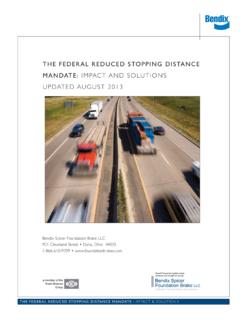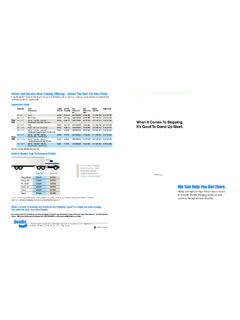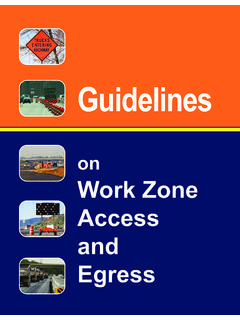Transcription of RULES & REGULATIONS - Connecticut
1 R U L E S & R E G U L AT I O N S. Aids to Navigation NAVIGATION AIDS REGULATORY MARKERS. Lateral Aids Safe Water Aids Information Marking the sides of channels as seen when placed inside Speed approaching from seaward or outside Restriction the rectangle, placed inside such as or outside directions, the circle. distances, or locations. Information Slow-No-Wake Explanation The nature of placed outside the danger Odd numbers Can buoy Even numbers Marking midchannels the crossed dia- placed inside and fairways Port Side (Unlighted) Starboard Side (No numbers. Buoys mond, such as or outside the Lighted buoy Lighted buoy may be lettered.) dam, rapids, or diamond. (green light only) (red light only) Lighted swim area. (White Light). Boat Exclusion Area Danger Preferred channel PREFERRED Preferred channel to starboard CHANNEL AIDS to port Not numbered. May be Lettered. The Sound Signals All vessels are required to exchange sound signals when their paths will lead them into close quarters.
2 Depending upon the size of your vessel, a mouth, hand or power oper- ated whistle or horn is required. The following four signals are the only signals that may be used by vessels, when Lighted buoy Can buoy Nun buoy within sight of each other, to signal their intentions. Lighted buoy (Green light)) (Unlighted) (Unlighted) (Red light) One short blast I intend to leave you on my port side. Two short blasts I intend to leave you on my star- board side. Three short blasts Indicates the operation of astern propulsion. Marker (Buoy or Beacon) Permits Five or more blasts Indicates danger. The placement of regulatory, navigational markers, slalom course buoys or jumps requires a permit from the Anchor Lights DEEP. Regulatory markers denote swim areas, speed zones, All vessels, when at anchor outside an officially marked danger areas or information. Navigational markers designate anchorage, must exhibit, an all-around white light. channels. Markers must meet DEEP specifications regarding size, color, banding, symbols and wording.
3 On tidal waters, a permit is required from both the DEEP and USCG. Visit the High Speed Ferries DEEP website at and click on High Speed Ferries (HSF) are capable of speeds of Laws / REGULATIONS / Permits. 60 knots (70 miles per hour) and above. When a HSF is NOTE: Permits for mooring buoys on tidal waters are approaching: issued by the Town, local Harbor Master, or the DEEP Office Know and obey the USCG RULES of the road. of Long Island Sound Programs, and on inland waters by the Make any changes in course or speed early and Town or an applicable power generating company. obvious to the HSF operator, and while still at least one mile from the ferry. At night and in times of restricted visibility, display cor- rect running lights and show a radar reflector. Monitor VHF. Channel 13 for announcements from the ferry. 56 2018 Connecticut BOATERS GUIDE. R U L E S & R E G U L AT I O N S. POWER-DRIVEN VESSELS. Navigation Lights (Underway). Recreational boats must display their required navi- gation lights at all times between sunset and sunrise, and during daylight periods of reduced visibility.
4 Shown below are the lights required. POWER-DRIVEN VESSELS. NON-POWERED VESSELS. Alternate lighting for boats less than 39'5" in length Navigation RULES Sailing vessel Rowboat or canoe Sailboat under sail alone less than 23'. Minimum requirement The lighting arrangements shown in the figures here have been taken from the Coast Guard Navigation RULES , International-Inland. TERMS TO KNOW: Stand-on vessel: The vessel that should maintain its course and speed (unless collision is imminent.). Give-way vessel: The vessel that must take early and sub- MEETING stantial action to avoid collision by stopping, slowing down, or CROSSING changing course. OVERTAKING. 2018 Connecticut BOATERS GUIDE 57. R U L E S & R E G U L AT I O N S. Movable Bridges The raising and lowering of train and traffic bridges are regulated by the US Coast Guard. You need to understand some critical information to safely pass under these bridges: Bridge clearance - is the distance between the water surface and the lowest portion of the bridge over the chan- nel.
5 This distance is measured in feet and can be found on the chart that the bridge is shown. Bridge clearances are referenced at mean high tide, with clearances changing throughout the tidal cycle. At low tide there will be more clearance than at an above average high tide. Many fixed and all moveable bridges will have a clear- ance gauge on each side of the bridge. This gauge will indi- cate the bridge clearance at the specific time you are pass- ing under the bridge. Each gauge is installed on the end of the right channel pier or pier protection structure facing approaching vessels and extends to a reasonable height above high water so as to be meaningful to the viewer. Other or additional locations may be used under particular conditions or circumstances. Air draft of a vessel - or vertical clearance is amount of vertical space that the boat needs to pass safely under an object. This distance is measured from the boat's waterline to the top of the highest structural object on the boat.
6 By federal regulation, movable antennas that are not essential to navigation and fishing poles cannot count in the measurement. They must be lowered. If after lowering all of the nonstructural and nonessential navigation components of your vessel, you still cannot pass under the bridge, you will need to contact the bridge tender. hailer, or other device capable of producing the described signals loud enough to be heard by the drawtender. The sound Signaling the Bridge: signal to request the opening of a draw is one prolonged blast Moveable bridges must open promptly and fully for the followed by one short blast sounded not more than three sec- passage of vessels when a request or signal to open is given. onds after the prolonged blast. However, there are bridges that have set opening and closing If the tender can open the bridge immediately, the reply schedules to facilitate the smooth flow of traffic so you may sound signal is one prolonged blast followed by one short blast have to wait.
7 Sounded within 30 seconds of the requesting signal. When There are several acceptable methods to contact the the draw cannot be opened immediately, the tender shall reply bridge tender to discuss scheduled openings and to request an with five short blasts sounded in rapid succession within 30. opening. The best method is by VHF marine radio via channel seconds of the vessel's opening signal. The signal shall be 13 using low power (one watt). The vessel repeated until acknowledged in some manner by the request- and the bridge tender shall monitor the ing vessel. frequency used until the vessel has cleared The visual signal to request the opening of a draw is a the draw. white flag raised and lowered vertically or a white, amber, or Using the radio, identify the name of green light raised and lowered vertically. The tender shall reply the bridge (repeated three times) you need in kind if the bridge can be opened or raise a red flag or swing opened and the name and description of a red light back and forth horizontally in full sight of the vessel your vessel (eg.)
8 Sailboat, 30 foot powerboat). Let the bridge within 30 seconds of the vessel's opening signal or show a tender know the direction you are headed and when you fixed or flashing red light(s) within 30 seconds of the vessel's request the opening. When radiotelephone contact cannot be opening signal and repeat until acknowledged in some manner initiated or maintained, sound or visual signals shall be used. by the requesting vessel. Sound signals shall be made by whistle, horn, megaphone, 58 2018 Connecticut BOATERS GUIDE. R U L E S & R E G U L AT I O N S. Five Short Blasts: If you hear this sound from the bridge and will help you to plan your trip, but you will still need to make your the bridge is open, it means the bridge is being closed. DO NOT intentions known to the bridge tender. TRY TO PASS through if you require an opening. The bridges are You should be familiar with the schedule for the bridges that you extremely heavy and are not easily stopped once the process has will use.
9 Their schedules are published in the USCG Local Notice begun. The bridge tender may not be able to see you; WAIT for the to Mariners ( ), cruising guides and next opening! other boating related publications. In areas where there is more than one moveable bridge, like New Haven Harbor, to eliminate confusion signals can vary. Checking QUICK GUIDE TO TRANSITING MOVABLE BRIDGES. the federal regulation cited above will provide those signals. Know the vertical clearance of your vessel (air draft). It is important to note that, the bridge tender shall take all Check the vertical clearance of the bridge. reasonable measures to have the draw opened, regardless of the Lower any moveable nonstructural objects or gear (radio operating schedule of the bridge, for passage of emergency vehicles, antennas, outriggers ) if necessary to pass without forcing a vessels or other emergency situations, provided this opening does bridge opening. IT IS ILLEGAL TO REQUEST AN OPENING without not conflict with local emergency management procedures which first lowering non-structural gear.
10 Have been approved by the cognizant Coast Guard Captain of the If an opening is required check for scheduled openings Port. Signal or contact the drawtender to request an opening When the bridge opens, pass through the draw as soon as Schedules for Bridges - Each movable bridge has its own possible in order to prevent unnecessary delays in the closure of the opening schedule that is determined by federal regulation. Between draw. May 15 and October 15, the five Amtrak movable Bridges will bridg- Do your part .. know your vertical clearance. Don't es reopen immediately after trains pass and will close in sufficient request unneeded openings. time for approaching trains to pass safely. Knowing the schedule Violation of other statutes not listed here may require a court appearance. Consult the statutes or applicable penalties. STATUTE NO. INFRACTION TOTAL AMOUNT DUE 15-140b Illegal marine parade, regattas, races 15-9(a) Failure to obey order of harbor master 15-140d Illegal obstruction to navigation or public use of waters 15-129(a)(1) Failure to comply with federal requirements regarding 15-140e Illegal operation of boat without a certificate or operators license personal flotation devices 15-140e(f) Unauthorized operation of a vessel engaged in water skiing 15-129(a)(1) Failure to comply with federal requirements for personal 15-140g Failure to carry boating operation certificate flotation devices and children 15-140h Illegal operation of a boat by a person less than 12 years old 15-129(a)(3) Failure to comply with federal requirements regarding 15-140j Permitting person less than 16 years old to operate a backfire flame controls personal watercraft without a certificate 15-129(a)(4) Defective muffling device 15-140j(g) Failure to have certificate of personal watercraft operation on 15-129(a)(5)














